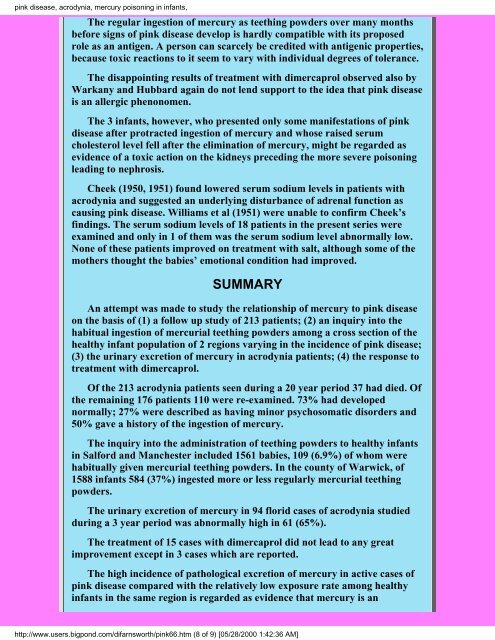You also want an ePaper? Increase the reach of your titles
YUMPU automatically turns print PDFs into web optimized ePapers that Google loves.
pink disease, acrodynia, mercury poisoning in infants,The regular ingestion of mercury as teething powders over many monthsbefore signs of pink disease develop is hardly compatible with its proposedrole as an antigen. A person can scarcely be credited with antigenic properties,because toxic reactions to it seem to vary with individual degrees of tolerance.The disappointing results of treatment with dimercaprol observed also byWarkany and Hubbard again do not lend support to the idea that pink diseaseis an allergic phenonomen.The 3 infants, however, who presented only some manifestations of pinkdisease after protracted ingestion of mercury and whose raised serumcholesterol level fell after the elimination of mercury, might be regarded asevidence of a toxic action on the kidneys preceding the more severe poisoningleading to nephrosis.Cheek (1950, 1951) found lowered serum sodium levels in patients withacrodynia and suggested an underlying disturbance of adrenal function ascausing pink disease. Williams et al (1951) were unable to confirm Cheek’sfindings. The serum sodium levels of 18 patients in the present series wereexamined and only in 1 of them was the serum sodium level abnormally low.None of these patients improved on treatment with salt, although some of themothers thought the babies’ emotional condition had improved.SUMMARYAn attempt was made to study the relationship of mercury to pink diseaseon the basis of (1) a follow up study of 213 patients; (2) an inquiry into thehabitual ingestion of mercurial teething powders among a cross section of thehealthy infant population of 2 regions varying in the incidence of pink disease;(3) the urinary excretion of mercury in acrodynia patients; (4) the response totreatment with dimercaprol.Of the 213 acrodynia patients seen during a 20 year period 37 had died. Ofthe remaining 176 patients 110 were re-examined. 73% had developednormally; 27% were described as having minor psychosomatic disorders and50% gave a history of the ingestion of mercury.The inquiry into the administration of teething powders to healthy infantsin Salford and Manchester included 1561 babies, 109 (6.9%) of whom werehabitually given mercurial teething powders. In the county of Warwick, of1588 infants 584 (37%) ingested more or less regularly mercurial teethingpowders.The urinary excretion of mercury in 94 florid cases of acrodynia studiedduring a 3 year period was abnormally high in 61 (65%).The treatment of 15 cases with dimercaprol did not lead to any greatimprovement except in 3 cases which are reported.The high incidence of pathological excretion of mercury in active cases ofpink disease compared with the relatively low exposure rate among healthyinfants in the same region is regarded as evidence that mercury is anhttp://www.users.bigpond.com/difarnsworth/pink66.htm (8 of 9) [05/28/2000 1:42:36 AM]


